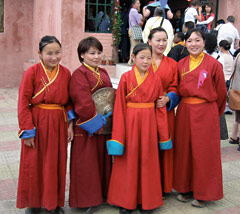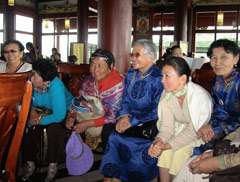Having read a biography of the great Mongolian conqueror Genghis Khan, I knew that in earliest times the Mongols worshipped the Eternal Blue Sky, but when I got off the plane at the Ulaanbaatar airport, I understood why. The sky over Mongolia is enormous, overarching, a bright clear blue.

Sandwiched between China and Russia, Mongolia is the world’s largest landlocked nation. The country, about the size of Alaska, has a population of slightly less than three million people— just a bit more than Chicago. Surrounded by huge spaces and open sky, the Mongolians have been nomadic people for centuries. Most still live in yurts (Mongolian, gers) and herd their horses, sheep, camels, and goats to graze across vast stretches of open land.
I came to Ulaanbaatar in early July 2008 to attend the Sakyadhita International Conference on Buddhist Women. Sakyadhita, which means “Daughters of the Buddha,” is the name of an organization founded in Bodhgaya, India, in 1987, to create an alliance for transforming the lives of women in Buddhist societies. This was the tenth gathering in 20 years, convening participants to work for compassionate social action and gender equity in Buddhism through education, training, and publications for Buddhist women. Among the 400 participants, 30 countries were represented— from Vietnam to Canada to Malaysia, from Bangladesh to Germany to Sri Lanka.
The recent history of Mongolia gave particular resonance to the conference. Mongolia had been a strongly Buddhist country, practicing a form of Tibetan Buddhism for centuries, until the USSR invaded in 1921. In the 1930s, the Soviets began purging Buddhists. An estimated 17,000 high-ranking monks were arrested and persecuted. Thousands of monks were killed, while younger monks were conscripted. The Communists closed down 700 temples, destroyed monasteries, and stole religious treasures.
For nearly 70 years, Mongolians lived under Communist rule. Then, in 1990, after the dissolution of the USSR, social democratic movements took power from the Communists. For the last 19 years, the country has been transitioning from its status as a satellite of the Soviet Union to a form of capitalist democracy.
This shift has had both positive and negative effects. (Violent political demonstrations took place in Ulaanbaatar while we were there.) But one major dimension of the transition is the reconstruction and revival of Buddhist practices and institutions.
Approximately 81 percent of Mongolians profess a faith in Buddhism and Buddhist teachings. There is even a Buddhist radio station in Ulaanbaatar called “Three Jewels.” An Association of Mongolian Buddhist Students boasts 1,500 members, the majority of whom are women, and some Buddhist women’s groups have formed. But because any expression of religion or spirituality was forbidden and severely punished for 70 years, the Mongolians have lost much of their Buddhist history and practices. Each morning for the duration of the five-day Sakyadhita conference, between 150 and 200 Mongolian women got on buses in Ulaanbaatar, the capital city, and came out to where the conference was held to ask us about Buddhist practice. They were passionately hungry for any information we could give them. Through their young ad hoc translators, they asked us endless questions: How did you come to Buddhism? Why did you become a Buddhist? Were your parents Buddhists? How long have you practiced? Has it changed your life? What practices do you do?
A typical discussion group would consist of six or eight of us foreigners—perhaps a woman from Thailand, three nuns from Korea, a laywoman from the U.S., two Vietnamese nuns—and then, filling out the circle, twenty or more Mongolian women, eagerly leaning forward, wanting to connect with us. When it was our turn to ask questions of them, they told us about the groups they are establishing, their efforts at translation and teaching lovingkindness, their work for the rights of women and in bringing women together from all of Mongolia, and their work teaching and caring for children.
Our sharing touched my heart. We international women had come to talk with each other about Buddhist women’s issues, to present papers on panels and hold discussion groups. But we found that what was being asked of us now was to give a great deal every day to our Mongolian sisters. They wanted our information, our insights, our enthusiasm, our experience. This vibrant exchange sometimes exhausted me, but I felt that offering our Buddhist practice and experience there was auspicious, that we were being of use to these women.

The conference held some unique opportunities. For instance, Tara appeared one day among us. We had been told that in Mongolia three women are recognized as living emanations of Tara, the most popular and best-known Tibetan Buddhist goddess, who represents compassion and the culmination of the spiritual path. One of these Taras had come from Western Mongolia to visit us. There she was, plump and wearing a yellow beanie, surrounded by women offering scarves for her blessing.
Watching this, I hesitated. After all, I’m not a Tibetan Buddhist—and could this really be a living emanation of Tara? Then I thought, Gee, if this really is Tara, available to bless us, what a fool I would be not to take advantage of the offer!
So I bowed before her and offered the customary scarf, which she draped over my neck. I felt her blowing on the top of my head, speaking words in Mongolian. (A friend said later that she was spitting on me.) As instructed, I slipped her some Mongolian money, which she tucked in her robe.
As I walked about, after the blessing, in the bright sunshine beneath that immense vivid sky, my mind felt clear and open. I thought of Maurine Stuart Roshi’s speaking of the “clear light in the mind.” This feeling stayed with me for quite a while, and I thought, Hmmm, maybe that really was Tara…
But the most striking Mongolian experience came as we did a short tour after the sessions ended. We were taken to the Narkhajid Monastery, a women’s temple where the reigning deity is Vajrayogini. This Tantric Buddhist meditation deity embodies the fully enlightened, female, wild, fiery, and energetic (shakti, kundalini) aspects of a Buddha.
There she was, at the front of the small, crowded temple: a painting of a naked dancing female in a seductive pose. Two lines of red-robed women (most of them young) performed a long chanting ceremony, wielding a drum in one hand, a bell in the other, now and then putting down the bell and drum to blow a thigh trumpet, a horn made from a human thigh bone. Long black fringe covered their faces so that you could not see their eyes or mouths. They were doing the chöd practice— feeding the demons.
We were told that before undertaking this particular chanting ceremony, the women stay up all night for nine nights in preparation, preferably in a cemetery. To hear these women chanting, to watch them perform the rites, thrilled me. It felt ancient, shamanic—women’s primeval power expressing itself.
These days, as every part of the world is beginning to be dependent upon, enriched by, connected with every other part, for good or ill, the Sakyadhita Conference in Mongolia represents, for me, a wholesome aspect of this rapid globalization. We Buddhist women from other countries had something to give—and a great deal to learn—as we connected with the people, the spiritual tradition, the politics, the land, and the Eternal Blue Sky.
Thank you for subscribing to Tricycle! As a nonprofit, we depend on readers like you to keep Buddhist teachings and practices widely available.